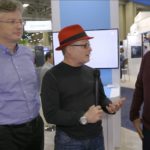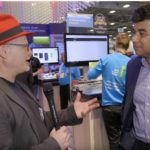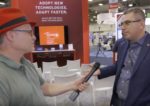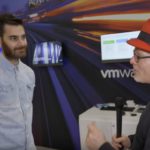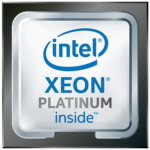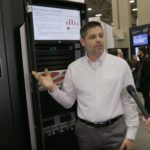In this video from SC18 in Dallas, Altair CTO Sam Mahalingam describes how the company’s PBS works software helps manufacturers build better products with design innovation driven by HPC. Now, with advent of Machine Learning and analytics, the company is helping customers move forward to a new age of data-driven design. After that, Chief Scientist . Andrea Casotto from Altair describes how Altairs “obsessively efficient” approach drives EDA automation.
How Lenovo is Helping Build Ai Solutions to Solve the World’s Toughest Challenges
In this video from SC18 in Dallas, Madhu Matta from Lenovo describes how the company is driving HPC & Ai technologies for Science, Research, and Enterprises across the globe. “Lenovo cares about solving real-world problems, and working with researchers is one of the best ways to gather insights from those whose daily work involves high-computing data and analytics to do just that.”
Video: Lenovo Leads the TOP500 with Innovative HPC Cooling Technologies
In this video from SC18 in Dallas, Scott Tease from Lenovo describes how the company is leading the TOP500 with innovative HPC cooling technologies. “At #8 on the TOP500, the Lenovo-built, hot-water cooled SuperMUC system at the LRZ in Germany is one of the most power efficient supercomputers on the planet. With more than 241,000 cores and a combined peak performance of the two installation phases of more than 6.8 Petaflops.”
Interview: The Importance of the Message Passing Interface to Supercomputing
In this video, Mike Bernhardt from the Exascale Computing Project catches up with ORNL’s David Bernholdt at SC18. They discuss supercomputing the conference, his career, the evolution and significance of message passing interface (MPI) in parallel computing, and how ECP has influenced his team’s efforts.
Red Hat Steps Up with HPC Software Solutions at SC18
In this video from SC18 in Dallas, Yan Fisher and Dan McGuan from Red Hat describe the company’s powerful software solutions for HPC and Ai workloads. “All supercomputers on the coveted Top500 list run on Linux, a scalable operating system that has matured over the years to run some of the most critical workloads and in many cases has displaced proprietary operating systems in the process. For the past two decades, Red Hat Enterprise Linux has served as the foundation for building software stacks for many supercomputers. We are looking to continue this trend with the next generation of systems that seek to break the exascale threshold.”
VMware Powers Machine Learning & HPC Workloads
In this video from SC18 in Dallas, Ziv Kalminovich from VMware describes how the company’s powerful virtualization capabilities bring flexibility and performance to HPC workloads. “With VMware, you can capture the benefits of virtualization for HPC workloads while delivering performance that is comparable to bare-metal. Our approach to virtualizing HPC adds a level of flexibility, operational efficiency, agility and security that cannot be achieved in bare-metal environments—enabling faster time to insights and discovery.”
Intel Pushes the Envelope at SC18
Intel has a long history of making important announcements at the annual Supercomputer shows, and this year was no exception. This guest post from Intel covers what new technology was front and center from Intel at SC18, including its Cascade Lake advanced performance processors, Intel Optane Persistent Memory and more. Learn more about these new technologies designed to accelerate the convergence of high-performance computing and AI.
Video: How OpenACC Enables Scientists to port their codes to GPUs and Beyond
In this video SC18, Jack Wells from ORNL describes how OpenACC enables scientists to port their codes to GPUs and other HPC platforms. “OpenACC, a directive-based high-level parallel programming model, has gained rapid momentum among scientific application users – the key drivers of the specification. The user-friendly programming model has facilitated acceleration of over 130 applications including CAM, ANSYS Fluent, Gaussian, VASP, Synopsys on multiple platforms and is also seen as an entry-level programming model for the top supercomputers (Top500 list) such as Summit, Sunway Taihulight, and Piz Daint. As in previous years, this BoF invites scientists, programmers, and researchers to discuss their experiences in adopting OpenACC for scientific applications, learn about the roadmaps from implementers and the latest developments in the specification.”
Video: Arm + Lustre in HPC
In this video from DDN booth at SC18, Brent Gorda from ARM presents: Arm + Lustre in HPC. At the show, DDN announced that its Whamcloud division is delivering professional support for Lustre clients on Arm architectures. With this support offering, organizations can confidently use Lustre in production environments, introduce new clients into existing Lustre infrastructures, and deploy Arm-based clusters of any size within test, development or production environments. As the use of Lustre continues to expand across HPC, artificial intelligence and data-intensive, performance-driven applications, the deployment of alternative architectures is on the rise.
A Look inside the new HPE Adaptive Rack Cooling System for HPC
In this video from SC18 in Dallas, Larry Keller from HPE describes the company’s innovative new Adaptive Rack Cooling System for HPC. “Efficient high-performance computing is a key to success in any business. But it can be daunting to design, deploy, and manage. Make sure that you get the best for your needs. Work with a partner with proven technology and a track record of delivering and supporting successful HPC deployments. HPE has decades of experience in HPC systems, and the proven products and expertise you need.”

